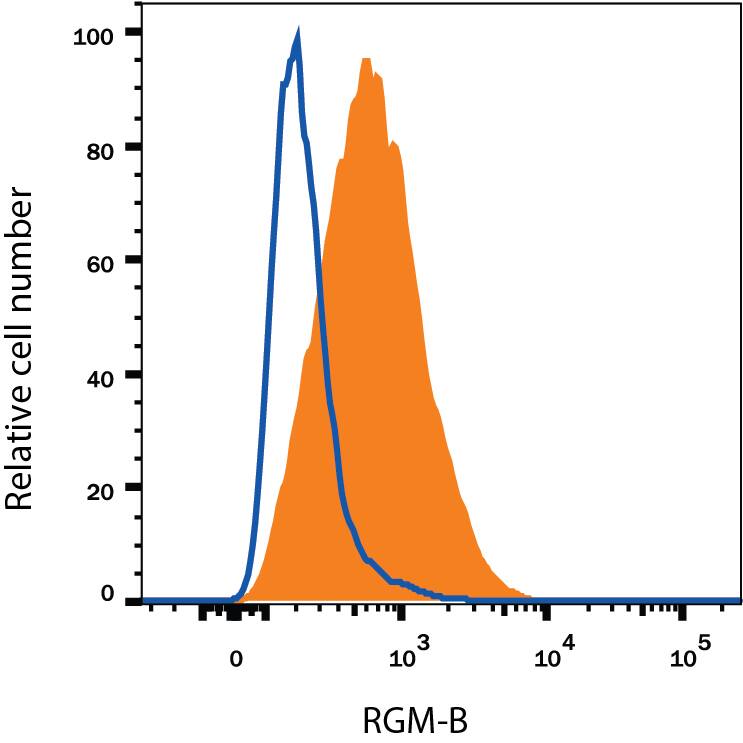Human RGM-B Antibody
R&D Systems, part of Bio-Techne | Catalog # AF3630

Key Product Details
Species Reactivity
Applications
Label
Antibody Source
Product Specifications
Immunogen
Gly46-SerSer411
Accession # Q6NW40
Specificity
Clonality
Host
Isotype
Scientific Data Images for Human RGM-B Antibody
Detection of RGM‑B in A172 Human Cell Line by Flow Cytometry.
A172 human glioblastoma cell line was stained with Goat Anti-Human RGM-B Antigen Affinity-purified Polyclonal Antibody (Catalog # AF3630, filled histogram) or isotype control antibody (Catalog # AB-108-C, open histogram), followed by Allophycocyanin-conjugated Anti-Goat IgG Secondary Antibody (Catalog # F0108). View our protocol for Staining Membrane-associated Proteins.Applications for Human RGM-B Antibody
CyTOF-ready
Flow Cytometry
Sample: A172 human glioblastoma cell line
Western Blot
Sample: Recombinant Human RGM-B (Catalog # 3630-RG)
Formulation, Preparation, and Storage
Purification
Reconstitution
Formulation
Shipping
Stability & Storage
- 12 months from date of receipt, -20 to -70 °C as supplied.
- 1 month, 2 to 8 °C under sterile conditions after reconstitution.
- 6 months, -20 to -70 °C under sterile conditions after reconstitution.
Background: RGM-B
RGM-B, also known as DRAGON, is a 40 kDa member of the repulsive guidance molecule (RGM) family of GPI-linked neuronal and muscle membrane proteins (1, 2). It is synthesized as a preproprotein that consists of a 45 amino acid (aa) signal sequence, a 368 aa mature region, and a 24 aa C-terminal prosegment (3). RGM-B contains an RGD motif, two potential N-linked glycosylation sites, and an abbreviated von Willebrand factor domain. There is a potential proteolytic cleavage site within the VWF domain (4). Alternative splicing may generate isoforms of RGM-B with N-terminal extensions or truncation following the VWF domain. Mature human RGM-B shares 52% and 36% aa sequence identity with the comparable regions of RGM-A and RGM-C, respectively. It shares 98%, 92%, 92%, and 78% aa sequence identity with macaque, mouse, bovine, and chicken RGM-B, respectively. RGM-B is expressed in the developing and adult nervous system, particularly in the dorsal root ganglia and mantle layer of the spinal cord (3‑5). In mouse, it shows a complementary, non-overlapping distribution with RGM-A (2‑5). RGM-B is also expressed in fetal and adult enteric ganglia and in postnatal intestinal epithelium (6). RGM-B expression has been detected in neuronal cell bodies and proximal axonal segments (4) but is also present on the cell surface, where it interacts homophilically and mediates neuronal adhesion (3). RGM-B additionally functions as a BMP coreceptor. It directly binds BMP-2 and -4 but not other TGF-beta family proteins (7). RGM-B associates with BMP type I (ALK-2, -3, -6) and type II (Activin RIIA, Activin RIIB) receptors and enhances BMP signaling (7).
References
- Monnier, P.P. et al. (2002) Nature 419:392.
- Schmidtmer, J. and D. Engelkamp (2004) Gene Exp. Patterns 4:105.
- Samad, T.A. et al. (2004) J. Neurosci. 24:2027.
- Niederkofler, V. et al. (2004) J. Neurosci. 24:808.
- Oldekamp, J. et al. (2004) Gene Exp. Patterns 4:283.
- Metzger, M. et al. (2005) Dev. Dyn. 234:169.
- Samad, T.A. et al. (2005) J. Biol. Chem. 280:14122.
Long Name
Alternate Names
Gene Symbol
UniProt
Additional RGM-B Products
Product Documents for Human RGM-B Antibody
Product Specific Notices for Human RGM-B Antibody
For research use only
